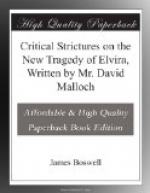One of Mallet’s duties, when he was janitor of the High School of Edinburgh, had been to assist in the floggings, either by applying the instrument of punishment himself (see LJ, p. 209) or by lifting the boys up on his back at the command of tollatur and exposing the proper portion of their anatomy to the master’s birch (John Ramsay, Scotland and Scotsmen in the Eighteenth Century, Blackwood, Edinburgh and London, 1888, i. 24 n.)]
[Footnote F: (Pp. 23-24) “... keen Distress of a Belvidera,... Dignity of an Elizabeth;... wild Madness of a Lear.” The authors are listing what they conceive to be the most impressive tragic roles of Mrs. Cibber, Mrs. Pritchard, and Garrick, who played respectively Elvira, the Queen, and the King in Elvira. Belvidera in Otway’s Venice Preserved was by all accounts one of Mrs. Cibber’s best parts. It had been assigned to her in the majority of the Drury Lane performances since 1747, and she had appeared in it as recently as 16 November 1762. Mrs. Pritchard had played Queen Elizabeth in all the Drury Lane performances (1755-1760) of The Earl of Essex by Henry Jones and of the play of the same name by Henry Brooke (1761-), but had appeared in neither role more recently than 30 December 1761. A role of Elizabeth which she had presented more recently (18 December 1762) and had been appearing regularly in since 1748 was the Queen Elizabeth of Shakespeare’s Richard III as altered by Cibber. It is probably this last named Elizabeth that the authors of Critical Strictures had in mind. The choice is unusual, critics generally having considered Lady Macbeth to be her finest tragic role. Garrick had played Lear on 31 December 1762 (Drury Lane Calendar, as above, pp. 237-238, 268, 313-315, 338).]
* * * * *
PUBLICATIONS OF THE AUGUSTAN REPRINT SOCIETY
FIRST YEAR (1946-47)
Numbers 1-4 out of print.
5. Samuel Wesley’s Epistle to a Friend Concerning Poetry (1700) and Essay on Heroic Poetry (1693).
6. Representation of the Impiety and Immorality of the Stage (1704) and Some Thoughts Concerning the Stage (1704).
SECOND YEAR (1947-1948)
7. John Gay’s The Present State of Wit (1711); and a section on Wit from The English Theophrastus (1702).
8. Rapin’s De Carmine Pastorali, translated by Creech (1684).
9. T. Hanmer’s (?) Some Remarks on the Tragedy of Hamlet (1736).
10. Corbyn Morris’ Essay towards Fixing the True Standards of Wit, etc. (1744).
11. Thomas Purney’s Discourse on the Pastoral (1717).
12. Essays on the Stage, selected, with an Introduction by Joseph Wood Krutch.




